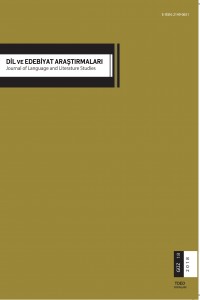Abstract
Howards End presents a world in flux and mobility in the advent of modernism where art and literature are tested for their ability to save the individual in the context of a quest for an English house, Howards End, which on a symbolic level represents not only the English but all humanity. Forster shows the world of literature and art in a very pessimistic and critical way with an emphasis on the lower-class’ futile striving for art and culture and on the over determination of class differences even for a cultivated upper-class individual with socialist aspirations. The destruction of the lower class, represented by Leonard, by the two upper-class families, the Schlegels, representing the German idealism and the Wilcoxes, the brutal capitalists, shows that appreciation of art does not make the refined mind immune to sharing a common ground with the philistine upper-class. Forster suggests that literature does not have the power to change the society, and that class and gender hierarchy cannot be overcome by literature or art.
Keywords
References
- Mathew Arnold (1993). ‘The Function of Criticism at the Present Time”, The Norton Anthology: English Literature II, New York: W. W. Norton & Company, Inc. 6th ed., p.1397 Austen, Jane (1994), Pride and Prejudice, London: Penguin Group. Berlin, Isaiah (2004), Romantikliğin Kökleri, trans. Mete Tunçay, İstanbul: YKY. Forster, E.M. (1987), Howards End, ed. Oliver Stallybrass, London: Penguin. Green. Robert (1969 January), “Messrs Wilcox and Kurtz, Hallow Men”, Twentieth Century Literature, Vol. 14, No.4, p.231- 239. Helfer, Martha B.(1996 Spring), ‘Dorothea Veit-Schlegel’s Florentin: Constructing a Feminist Romantic Aesthetic’, The German Quarterly, Vol. 69. No. 2, p. 144-160. Hodge, Elizabeth (2006 Summer), ‘The Mysteries of Eleusis at Howards End: German Romanticism and the Making of a Mythology for England’, International Journal of the Classical Tradition, Vol. 13, No. 1, p. 33-68. Hoy, Cyrus (1960 March), ‘Forster’s Metaphysical Novel’, PMLA, Vol. 75, No 1, p. 126-136. Hoy II, Pat C. (1985 Summer-Autumn), ‘The Narrow, Rich Staircase in Forster’s Howards End’, Twentieth Century Literature, Vol. 31, No.2/3, p. 221-235. Lange, Victor (1955 Autumn), ‘Friedrich Schlegel’s Literary Criticism’, Comparative Literature Vol. 7, No.4, p. 289-305. Littau, Karen (2006), Theories of Reading: Books, Bodies and Bibliomania, Cambridge: Polity Press. Ruskin, John (1993), ‘From The Stones of Venice’, The Norton Anthology: English Literature 2, New York: W. W. Norton & Company, Inc. Sixth ed. Shiner, Larry (2001), The Invention of Art: A Cultural History, Chicago: Chicago UP. Tompkins, Jane P. (1980), ‘The Reader in History: The Changing Shape of Literary Response’, Reader-Response Criticism: From Formalism to Post-structuralism, ed. Jane P. Tompkins, Maryland: The John Hopkins UP.
Abstract
References
- Mathew Arnold (1993). ‘The Function of Criticism at the Present Time”, The Norton Anthology: English Literature II, New York: W. W. Norton & Company, Inc. 6th ed., p.1397 Austen, Jane (1994), Pride and Prejudice, London: Penguin Group. Berlin, Isaiah (2004), Romantikliğin Kökleri, trans. Mete Tunçay, İstanbul: YKY. Forster, E.M. (1987), Howards End, ed. Oliver Stallybrass, London: Penguin. Green. Robert (1969 January), “Messrs Wilcox and Kurtz, Hallow Men”, Twentieth Century Literature, Vol. 14, No.4, p.231- 239. Helfer, Martha B.(1996 Spring), ‘Dorothea Veit-Schlegel’s Florentin: Constructing a Feminist Romantic Aesthetic’, The German Quarterly, Vol. 69. No. 2, p. 144-160. Hodge, Elizabeth (2006 Summer), ‘The Mysteries of Eleusis at Howards End: German Romanticism and the Making of a Mythology for England’, International Journal of the Classical Tradition, Vol. 13, No. 1, p. 33-68. Hoy, Cyrus (1960 March), ‘Forster’s Metaphysical Novel’, PMLA, Vol. 75, No 1, p. 126-136. Hoy II, Pat C. (1985 Summer-Autumn), ‘The Narrow, Rich Staircase in Forster’s Howards End’, Twentieth Century Literature, Vol. 31, No.2/3, p. 221-235. Lange, Victor (1955 Autumn), ‘Friedrich Schlegel’s Literary Criticism’, Comparative Literature Vol. 7, No.4, p. 289-305. Littau, Karen (2006), Theories of Reading: Books, Bodies and Bibliomania, Cambridge: Polity Press. Ruskin, John (1993), ‘From The Stones of Venice’, The Norton Anthology: English Literature 2, New York: W. W. Norton & Company, Inc. Sixth ed. Shiner, Larry (2001), The Invention of Art: A Cultural History, Chicago: Chicago UP. Tompkins, Jane P. (1980), ‘The Reader in History: The Changing Shape of Literary Response’, Reader-Response Criticism: From Formalism to Post-structuralism, ed. Jane P. Tompkins, Maryland: The John Hopkins UP.
Details
| Primary Language | English |
|---|---|
| Journal Section | ARTİCLES |
| Authors | |
| Publication Date | October 19, 2018 |
| Acceptance Date | August 28, 2018 |
| Published in Issue | Year 2018 Volume: 18 Issue: 18 |
Journal of Language and Literature Studies is licensed under the Creative Commons Attribution-Non-Commercial-NoDerivatives 4.0 International Licence (CC BY-NC-ND 4.0).

